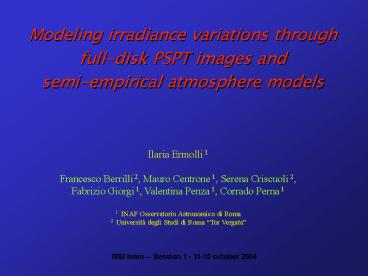Nessun titolo diapositiva PowerPoint PPT Presentation
1 / 31
Title: Nessun titolo diapositiva
1
Modeling irradiance variations through full-disk
PSPT images and semi-empirical atmosphere models
Ilaria Ermolli 1 Francesco Berrilli 2, Mauro
Centrone 1, Serena Criscuoli 2, Fabrizio Giorgi
1, Valentina Penza 1, Corrado Perna 1 1 INAF
Osservatorio Astronomico di Roma 2 Università
degli Studi di Roma Tor Vergata
ISSI team Session 1 - 11-15 october 2004
2
COMBINED USE OF SEMI-EMPIRICAL MODELS AND
PHOTOMETRIC FULL-DISK IMAGES
Rome-PSPT Observing Program
Spectrum synthesis RISE and SATIRE models
Photometric properties of the Solar features
along the cycle
Intensity for the various structures
Spectral synthesis
Test the capability of the models to reproduce
the emergent intensity
Reconstruction of the disk integrated spectrum
(VIRGO SSI - TSI)
3
COMBINED USE OF EMPIRICAL MODELS AND PHOTOMETRIC
FULL-DISK IMAGES
Rome-PSPT Observing Program
Spectrum synthesis RISE and SATIRE models
Photometric properties of the Solar features
along the cycle
Intensity for the various structures
Spectral synthesis
Test the capability of the models to reproduce
the emergent intensity
Reconstruction of the disk integrated spectrum
(VIRGO SSI - TSI)
4
RISE models (Fontenla et al. 1999, ApJ, 518, 480)
Model Structure Min Max Disk
Coverage A Faint cell
interior 0.10 0.09 C Ave cell
interior 0.77 0.70 E Active
network 0.10 0.09 F Bright net/Faint
plage 0.03 0.06 H Ave plage 0 0.05 P
Bright plage 0 0.007 S Spot
umbra 0 0.003
5
SATIRE models Kurucz flux spectra FAL
modified (Solanki and Unruh 1998, AA, 329, 747,
..)
Model Structure FAL-C Quiet
Sun FAL-P Faculae Kurucz 4500 Spot
umbra Kurucz 5400 Spot Penumbra
6
COMBINED USE OF EMPIRICAL MODELS AND PHOTOMETRIC
FULL-DISK IMAGES
Rome-PSPT Observing Program
Spectrum synthesis RISE and SATIRE models
Photometric properties of the Solar features
along the cycle
Intensity for the various structures
Spectral synthesis
Test the capability of the models to reproduce
the emergent intensity
Reconstruction of the disk integrated spectrum
(VIRGO SSI - TSI)
7
Photometric properties of solar features along
the solar cycle
Ermolli et al. 2003, AA, 412, 857
8
COMBINED USE OF EMPIRICAL MODELS AND PHOTOMETRIC
FULL-DISK IMAGES
Rome-PSPT Observing Program
Spectrum synthesis RISE and SATIRE models
Photometric properties of the Solar features
along the cycle
Intensity for the various structures
Spectral synthesis
Test the capability of the models to reproduce
the emergent intensity
Reconstruction of the disk integrated spectrum
(VIRGO SSI - TSI)
9
Test the capability of the models to reproduce
the emergent intensity
Penza et al. 2002, PhD Thesis
10
Test the capability of the models to reproduce
the emergent intensity
Penza et al. 2004, AA, 413, 1115
11
Test the capability of the models to reproduce
the emergent intensity
Penza et al. 2004, AA, 413, 1115
12
Test the capability of the models to reproduce
the emergent intensity
SATIRE Blue
SATIRE Red
RISE Blue
RISE Red
Computed contrast of the solar structures for the
PSPT continuum bands
13
Test the capability of the models to reproduce
the emergent intensity
Mod E
Ermolli et al. 2003, AA, 412, 857
Mod H
Mod F
Penza et al. 2004, AA, 413, 1115
14
Test the capability of the models to reproduce
the emergent intensity
Slight model modifications to optimize details of
the comparison
Penza et al. 2004, AA, 413, 1115
Fontenla et al. 2004, ApJ, 605, L85
15
Test the capability of the models to reproduce
the emergent intensity main results
Mod E reproduces the network CLV
Computed/Measured 0.05 difference until m0.3
Blue continuum network contrast is very sensitive
both to the Filter pass-band and to the
microturbulence
Mod P and Mod H do not reproduce the measured
facular CLV
Mod F reproduces the facular CLV with a
difference less than 1 until m0.3
Mod P and Mod H produce negative continuum
facular contrast at the m1 , not measured
Slight model modifications to optimize details of
this comparison
16
COMBINED USE OF EMPIRICAL MODELS AND PHOTOMETRIC
FULL-DISK IMAGES
Rome-PSPT Observing Program
Spectrum synthesis RISE and No-Rise models
Disentangle facular CLV results
Intensity for the various structures
Measurement of network cycle variations
Spectral synthesis
Test the capability of the models to reproduce
the emergent intensity
Reconstruction of the disk integrated spectrum
(VIRGO SSI - TSI)
17
Reconstruction of the disk integrated spectrum
(VIRGO SSI - TSI)
PSPT CaII K-cont images 2000 days - VIRGO
(total-spectral) Threshold -contiguity
thecnique RISE SATIRE models
Model Structure Mod C Quiet Sun Mod
E Network Mod F Faculae Mod
H Faculae Mod S Spot Umbra Kurucz 4500 Spot
umbra Kurucz 5400 Spot Penumbra Tritschler and
Schmidt 2002, AA, 382, 1093
15 Jul 24 Aug 1996
18
Reconstruction of the disk integrated spectrum
(VIRGO SSI - TSI)
19
RECONSTRUCTION OF THE DISK INTEGRATED SPECTRUM
Count magnetic ingredients of solar variability
Evaluate their respective wheight
Study limitations of decomposing the Sun into
structures
20
Count magnetic ingredients of solar variability
21
Count magnetic ingredients of solar variability
22
Count magnetic ingredients of solar variability
23
Count magnetic ingredients of solar variability
24
Count magnetic ingredients of solar variability
25
Count magnetic ingredients of solar variability
MDI results by J. Pap and M. Turmon
26
Count magnetic ingredients of solar variability
27
Count magnetic ingredients of solar variability
28
Count magnetic ingredients of solar variability
29
Count magnetic ingredients of solar variability
5 components -gt 86 of TSI variance
30
Reconstruction of the disk integrated spectrum
(VIRGO SSI - TSI) Main results
Magnetic ingredients of solar variability
Spot (umbra, penumbra), faculae, network -gt 86
of TSI variance
Their respective weight
Whether variation of the coverage factors
alone and/or emergent intensity
Study limitations of decomposing the Sun into
structures
The use of a set of 1D models simplifies the
approach, but needs a correct determination of
the coverage factors, that are strongly dependent
on the feature identification procedures.
31
CONCLUSIONS
Models modifications to optimize details
Careful calibrations of synoptic observing
program results
Advanced image processing (image calibration
features identification)

